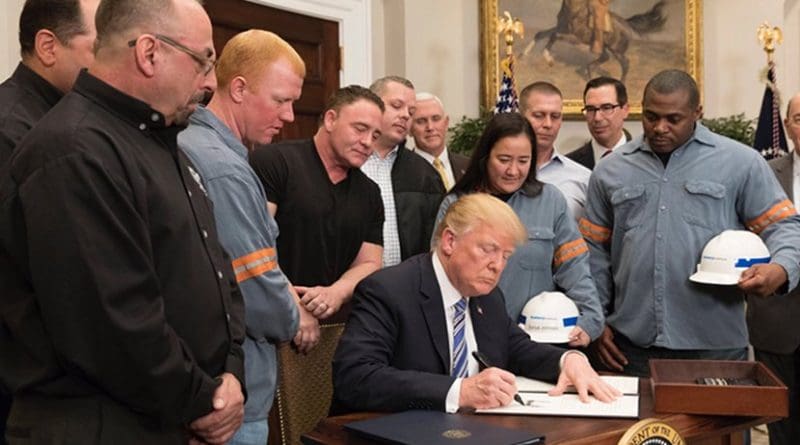Trump’s Tariffs And A Looming Trade War: India’s Stakes – Analysis
By IPCS
By Ayan Tewari*
As US President Donald Trump imposes steel and aluminium tariffs on most countries, India is in a unique position to capitalise on the situation. Trump’s tariffs could direct foreign steel and aluminium towards India, benefitting consumers, distributors, and middlemen alike. Additionally, further retaliation against the US could open a space for Indian producers to sell in markets abroad. However, India must avoid getting caught in the crossfire in the trade war, while still ensuring that domestic producers can deal with foreign competition.
After two years of speeches and threats accusing the rest of the world of taking advantage of the US, Trump finally levied tariffs on steel (25 per cent) and aluminium (10 per cent) on every country barring Canada, Mexico, the EU, Australia, South Korea, Brazil, and Argentina. However, the White House has made it clear that these exemptions are merely temporary (until 1 May 2018). The EU has threatened tariffs on various US products (Harley-Davidson, Levi’s, Kentucky Bourbon), and China has already retaliated, imposing duties of up to 25 per cent on US$ 5 billion worth of US imports, including US$ 1.2 billion worth of pork. In response, Washington drew up a list of 1,333 Chinese exports worth US$ 50 billion annually that it plans to impose tariffs up to 25 per cent on. China responded swiftly, presenting a list of 106 products worth US$ 50 billion, which it plans to also tax 25 per cent.
As opposed to European and Chinese companies, India barely relies on the US to satisfy its steel and aluminium surplus, with only 5 per cent of Indian steel going to the US, and most of India’s aluminium going to Southeast Asia. This limited reliance on the US provides India with a window of opportunity to take advantage of a trade war when juxtaposed with China’s recent pledge to fix the bilateral trade imbalance. The question is, how should India place itself in this situation while avoiding a trade war?
The direct short-term effect of the steel and aluminium tariffs will involve a surge of foreign steel and aluminium entering the Indian market. After 1 May, countries such as Russia, Turkey, and Japan, and others such as South Korea which have large stakes in US and Indian steel and aluminium markets, may seek to expand into India’s large consumer market. The government’s INR 5.97 trillion spending plan on infrastructure in the 2018-19 budget, combined with low transportation and labour costs, is likely to create a desirable market for foreign steel and aluminium. These imports will not only lower prices for Indian buyers, but may also disrupt the oligopoly plaguing the Indian steel market comprising TATA Steel Group, JSW Steel Limited and the Steel Authority of India Ltd. Additionally, the government and middlemen will obtain increased revenue, ultimately resulting in higher employment and more disposable funds.
Foreign companies in India may also resort to dumping, resulting in domestic producers being edged out of the market through unfair means. To avoid such negative effects, appropriate inspections, enforcement, and intelligent and targeted application of rules must be conducted, and smaller domestic firms and start-ups should be considered for subsidies to deal with competition from China and the EU. These steps can also help thwart the oligopoly.
While it is difficult for Indian companies to compete in China, the tariffs on Chinese products – such as low-end colour TVs (worth US$ 3.9 billion) – will leave a vacuum in the US market, one that Indian companies could possibly fill. Moreover, as the trade war intensifies, the US may impose duties on more Chinese products. While products that the US relies on – such as Chinese mobile phones and computing equipment – are not likely to be taxed, the multi-billion dollar industries of Chinese furniture (US$ 29 billion), toys (US$ 24 billion), and footwear (US$ 15 billion) might be under scrutiny, and prime opportunities for Indian companies to capitalise on.
The argument here is not for the imposition of duties. Rather, it is one where dumping and unfair trade practices are thwarted, while market rationalisation allows the export sector to function without subsidies. India has already come under immense scrutiny from the World Trade Organisation (WTO) for its export promotion schemes (Merchandise Exports from India Scheme, Export Oriented Units Scheme, Electronics Hardware Technology Parks Scheme, the Export Promotion Capital Goods Scheme), with both the US and Japan publicly accusing India of wrongdoing. The continuation of these programmes may antagonise more countries, and in today’s tense climate, trade sanctions must be avoided.
If carefully calibrated, these steps could, in the short-run, benefit Indian companies, giving them the advantage of lower prices and greater choice, and in the long-run, lead to the dismantling of oligopolies. However, if the government overplays its hands and engages in ham-handed protectionism such as subsidies on exporting firms, Indian jobs and revenue will be in peril due to retaliation.
*Ayan Tewari’s research focuses on South Asian political economy with a special focus on macroeconomic policies. Prior to joining IPCS, he interned with the Afghan Embassy in Berlin.

